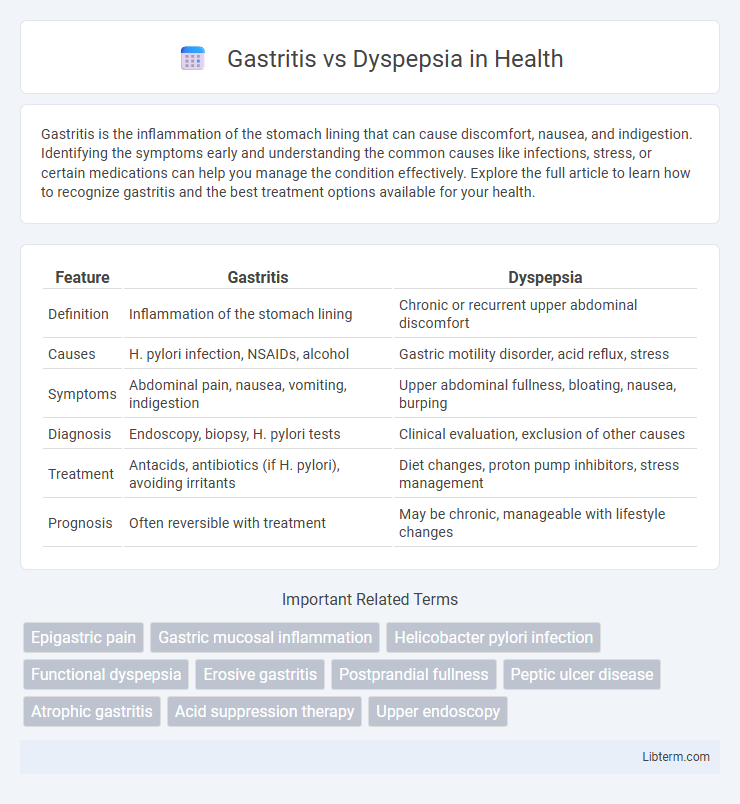Gastritis is the inflammation of the stomach lining that can cause discomfort, nausea, and indigestion. Identifying the symptoms early and understanding the common causes like infections, stress, or certain medications can help you manage the condition effectively. Explore the full article to learn how to recognize gastritis and the best treatment options available for your health.
Table of Comparison
| Feature | Gastritis | Dyspepsia |
|---|---|---|
| Definition | Inflammation of the stomach lining | Chronic or recurrent upper abdominal discomfort |
| Causes | H. pylori infection, NSAIDs, alcohol | Gastric motility disorder, acid reflux, stress |
| Symptoms | Abdominal pain, nausea, vomiting, indigestion | Upper abdominal fullness, bloating, nausea, burping |
| Diagnosis | Endoscopy, biopsy, H. pylori tests | Clinical evaluation, exclusion of other causes |
| Treatment | Antacids, antibiotics (if H. pylori), avoiding irritants | Diet changes, proton pump inhibitors, stress management |
| Prognosis | Often reversible with treatment | May be chronic, manageable with lifestyle changes |
Introduction to Gastritis and Dyspepsia
Gastritis is the inflammation of the stomach lining caused by factors such as Helicobacter pylori infection, excessive alcohol consumption, or prolonged use of NSAIDs, leading to symptoms like abdominal pain, nausea, and indigestion. Dyspepsia, commonly known as indigestion, refers to a group of symptoms including bloating, early satiety, and upper abdominal discomfort without an identifiable structural cause. Differentiating gastritis from dyspepsia involves clinical evaluation and diagnostic tools such as endoscopy and Helicobacter pylori testing to guide appropriate treatment strategies.
Definitions: What is Gastritis? What is Dyspepsia?
Gastritis is the inflammation of the stomach lining, often caused by Helicobacter pylori infection, long-term use of NSAIDs, or excessive alcohol consumption. Dyspepsia, also known as indigestion, refers to a group of symptoms including upper abdominal discomfort, bloating, and nausea, without necessarily indicating an underlying stomach inflammation. While gastritis is a specific pathological condition, dyspepsia describes a syndrome characterized by recurrent digestive discomfort.
Causes and Risk Factors
Gastritis is primarily caused by Helicobacter pylori infection, chronic use of NSAIDs, excessive alcohol consumption, and stress, leading to inflammation of the stomach lining. Dyspepsia, often resulting from functional disorders, GERD, or peptic ulcers, is triggered by factors such as poor diet, smoking, and Helicobacter pylori infection. Both conditions share risk factors like Helicobacter pylori infection and lifestyle habits, but gastritis involves direct mucosal inflammation, whereas dyspepsia relates to upper abdominal discomfort without necessarily visible inflammation.
Common Symptoms and Clinical Presentation
Gastritis and dyspepsia share common symptoms such as upper abdominal pain, bloating, nausea, and indigestion, but gastritis often includes a burning sensation or gnawing discomfort due to stomach lining inflammation. Dyspepsia primarily presents as postprandial fullness, early satiety, and epigastric pain without visible mucosal damage on endoscopy. Clinical presentation of gastritis may reveal mucosal erythema or erosions, whereas dyspepsia is diagnosed mainly based on symptom patterns and exclusion of organic diseases.
Diagnostic Criteria and Procedures
Gastritis diagnosis involves endoscopic examination revealing mucosal inflammation, along with histological biopsy confirming the presence of neutrophilic infiltration and Helicobacter pylori infection. Dyspepsia diagnosis primarily relies on clinical evaluation of symptoms like upper abdominal discomfort without evidence of organic disease, often followed by non-invasive tests such as Helicobacter pylori breath or stool antigen tests and abdominal ultrasound. Both conditions may require exclusion of peptic ulcer disease and malignancy through endoscopy to ensure accurate differentiation and tailored treatment strategies.
Key Differences Between Gastritis and Dyspepsia
Gastritis is inflammation of the stomach lining often caused by Helicobacter pylori infection, NSAID use, or excessive alcohol consumption, presenting with symptoms like burning stomach pain and nausea. Dyspepsia, commonly known as indigestion, involves chronic or recurrent upper abdominal discomfort, bloating, and early satiety, without significant structural abnormalities. Unlike gastritis, which can be confirmed through endoscopy and biopsy, dyspepsia is primarily diagnosed based on clinical symptoms and exclusion of other conditions.
Complications and Associated Health Risks
Gastritis can lead to serious complications such as gastric ulcers, bleeding, and an increased risk of stomach cancer, especially when caused by Helicobacter pylori infection. Dyspepsia, while often linked to indigestion and mild discomfort, may mask underlying conditions like peptic ulcers or gastroesophageal reflux disease (GERD), increasing the risk of esophageal damage. Both conditions require prompt diagnosis and management to prevent progression and severe health outcomes.
Treatment Approaches and Management
Treatment approaches for gastritis primarily involve eradicating Helicobacter pylori infection with antibiotics and using proton pump inhibitors (PPIs) to reduce stomach acid and promote mucosal healing. Dyspepsia management centers on lifestyle modifications, such as dietary changes and stress reduction, alongside pharmacological options including PPIs, H2 receptor antagonists, and prokinetics for symptom relief. Differentiating between gastritis and functional dyspepsia is crucial to tailor therapy effectively and optimize patient outcomes.
Prevention Strategies and Lifestyle Modifications
Preventing gastritis and dyspepsia primarily involves adopting a balanced diet rich in fiber, avoiding spicy, acidic, and fatty foods that can irritate the stomach lining. Regular meal patterns, limiting alcohol consumption, and quitting smoking significantly reduce gastric inflammation and minimize dyspeptic symptoms. Stress management techniques such as mindfulness and regular exercise contribute to maintaining digestive health and preventing flare-ups.
When to Seek Medical Attention
Seek medical attention for gastritis if symptoms include persistent stomach pain, vomiting blood, or black tarry stools, which may indicate bleeding or severe inflammation. Dyspepsia warrants medical evaluation when accompanied by weight loss, difficulty swallowing, or recurrent vomiting, suggesting underlying conditions like ulcers or gastrointestinal malignancies. Timely diagnosis through endoscopy and testing for Helicobacter pylori infection can guide effective treatment and prevent complications.
Gastritis Infographic

 libterm.com
libterm.com